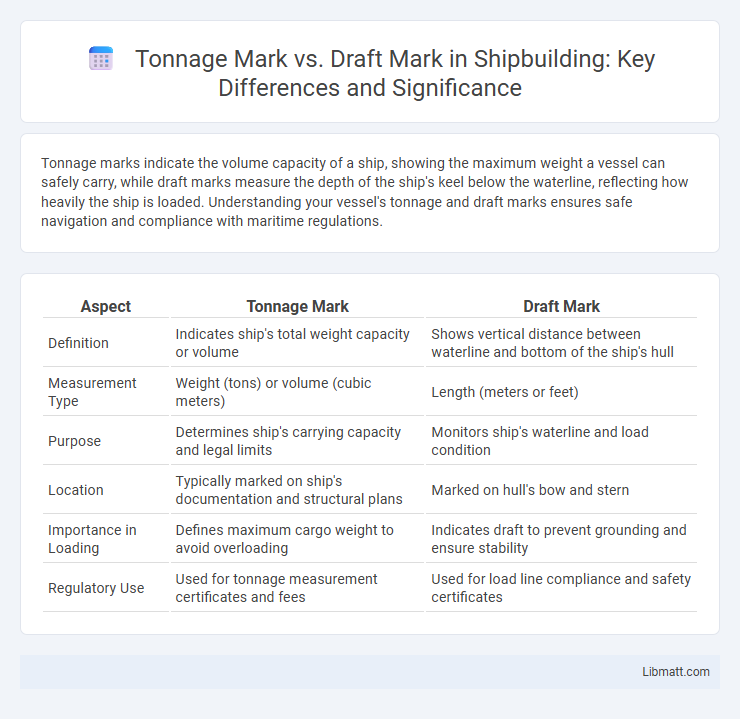Tonnage marks indicate the volume capacity of a ship, showing the maximum weight a vessel can safely carry, while draft marks measure the depth of the ship's keel below the waterline, reflecting how heavily the ship is loaded. Understanding your vessel's tonnage and draft marks ensures safe navigation and compliance with maritime regulations.
Table of Comparison
| Aspect | Tonnage Mark | Draft Mark |
|---|---|---|
| Definition | Indicates ship's total weight capacity or volume | Shows vertical distance between waterline and bottom of the ship's hull |
| Measurement Type | Weight (tons) or volume (cubic meters) | Length (meters or feet) |
| Purpose | Determines ship's carrying capacity and legal limits | Monitors ship's waterline and load condition |
| Location | Typically marked on ship's documentation and structural plans | Marked on hull's bow and stern |
| Importance in Loading | Defines maximum cargo weight to avoid overloading | Indicates draft to prevent grounding and ensure stability |
| Regulatory Use | Used for tonnage measurement certificates and fees | Used for load line compliance and safety certificates |
Introduction to Tonnage Marks and Draft Marks
Tonnage marks indicate a ship's total internal volume and are crucial for regulatory compliance and cargo capacity calculations. Draft marks represent the depth of water a vessel displaces by showing the vertical distance between the waterline and the bottom of the hull, essential for safe navigation and load management. Both marks serve distinct purposes in maritime operations, ensuring vessel stability and cargo handling efficiency.
Defining Tonnage Mark: Purpose and Placement
The tonnage mark on a ship indicates the vessel's total internal volume and is primarily used for regulatory and safety compliance. It is placed on the ship's hull, typically near the midship, to provide a clear reference point for calculating the ship's gross tonnage. This contrast with the draft mark, which measures the depth of the ship's keel below the waterline, highlighting different aspects of vessel measurement.
Understanding Draft Mark: Meaning and Importance
Draft marks indicate the vertical distance from the waterline to the bottom of a ship's keel, essential for determining vessel stability and ensuring safe navigation. Unlike tonnage marks that measure cargo capacity, draft marks help you assess how deeply a ship is submerged, directly affecting maneuverability and compliance with maritime regulations. Accurate reading of draft marks prevents grounding and supports load management, safeguarding both the vessel and its crew.
Historical Evolution of Ship Markings
Tonnage marks and draft marks have evolved as essential ship markings to ensure safety and regulatory compliance in maritime navigation. Historically, the tonnage mark, indicating a ship's internal volume, originated from 19th-century regulations aimed at standardizing freight measurements for taxation and safety purposes. Draft marks, showing the vessel's submerged depth, developed concurrently to monitor load limits and stability, reflecting advancements in naval engineering and international maritime standards.
Regulatory Bodies Governing Tonnage and Draft Marks
The International Maritime Organization (IMO) establishes regulations for tonnage marks under the International Convention on Tonnage Measurement of Ships, ensuring standardized measurement of a vessel's volume for safety and operational purposes. Draft marks are regulated by classification societies such as Lloyd's Register and the American Bureau of Shipping, supported by national maritime authorities, to guarantee compliance with load line conventions and safe loading limits. Both sets of marks are essential for monitoring vessel stability, safety, and adherence to international maritime laws enforced by flag state administrations.
Key Differences Between Tonnage Mark and Draft Mark
Tonnage marks indicate the total volume capacity of a ship's enclosed spaces, measured in gross or net tons, which is essential for regulatory and safety compliance. Draft marks represent the depth of the ship's keel below the waterline, helping to determine the vessel's current load and stability by showing how much of the hull is submerged. Understanding these key differences enables you to assess a ship's cargo capacity versus its real-time loading condition accurately.
Practical Significance for Ship Owners and Crew
Tonnage marks indicate a ship's internal volume essential for regulatory compliance, port fees, and cargo capacity planning, while draft marks measure the vessel's underwater depth critical for safe navigation and stability. Accurate reading of draft marks ensures your vessel avoids grounding and maintains optimal loading, directly impacting fuel efficiency and safety. Understanding both marks enables ship owners and crew to balance cargo loads effectively, adhere to maritime regulations, and optimize vessel performance.
Impact on Ship Loading and Safety Compliance
Tonnage marks indicate the vessel's volume and are crucial for determining cargo capacity limits, directly impacting ship loading efficiency. Draft marks measure the ship's submerged depth, ensuring safe loading within stability and navigational limits to prevent overloading. Understanding both marks helps you maintain safety compliance and avoid penalties from maritime regulatory bodies.
Inspection and Maintenance of Marks on Vessels
Tonnage marks and draft marks on vessels require regular inspection and maintenance to ensure accuracy and compliance with maritime safety regulations. Inspectors verify that the tonnage marks, which indicate the ship's volume capacity, remain clearly visible and free from damage or corrosion, while draft marks, showing the vessel's waterline depth, must be accurately calibrated and legible to prevent overloading. You should schedule routine cleaning, repainting, and measurement checks to maintain these marks in optimal condition for safe navigation and regulatory adherence.
Common Misconceptions and FAQs
Tonnage marks measure the vessel's internal volume for regulatory and safety purposes, while draft marks indicate the ship's vertical distance from the waterline to the keel, crucial for safe navigation. A common misconception is that tonnage marks show the ship's weight or cargo capacity, but they actually represent volume in cubic meters or register tons. FAQs often ask if draft marks change during loading; the answer is yes, as the ship sinks deeper with increased weight, affecting draft readings essential for avoiding groundings.
Tonnage mark vs draft mark Infographic

 libmatt.com
libmatt.com